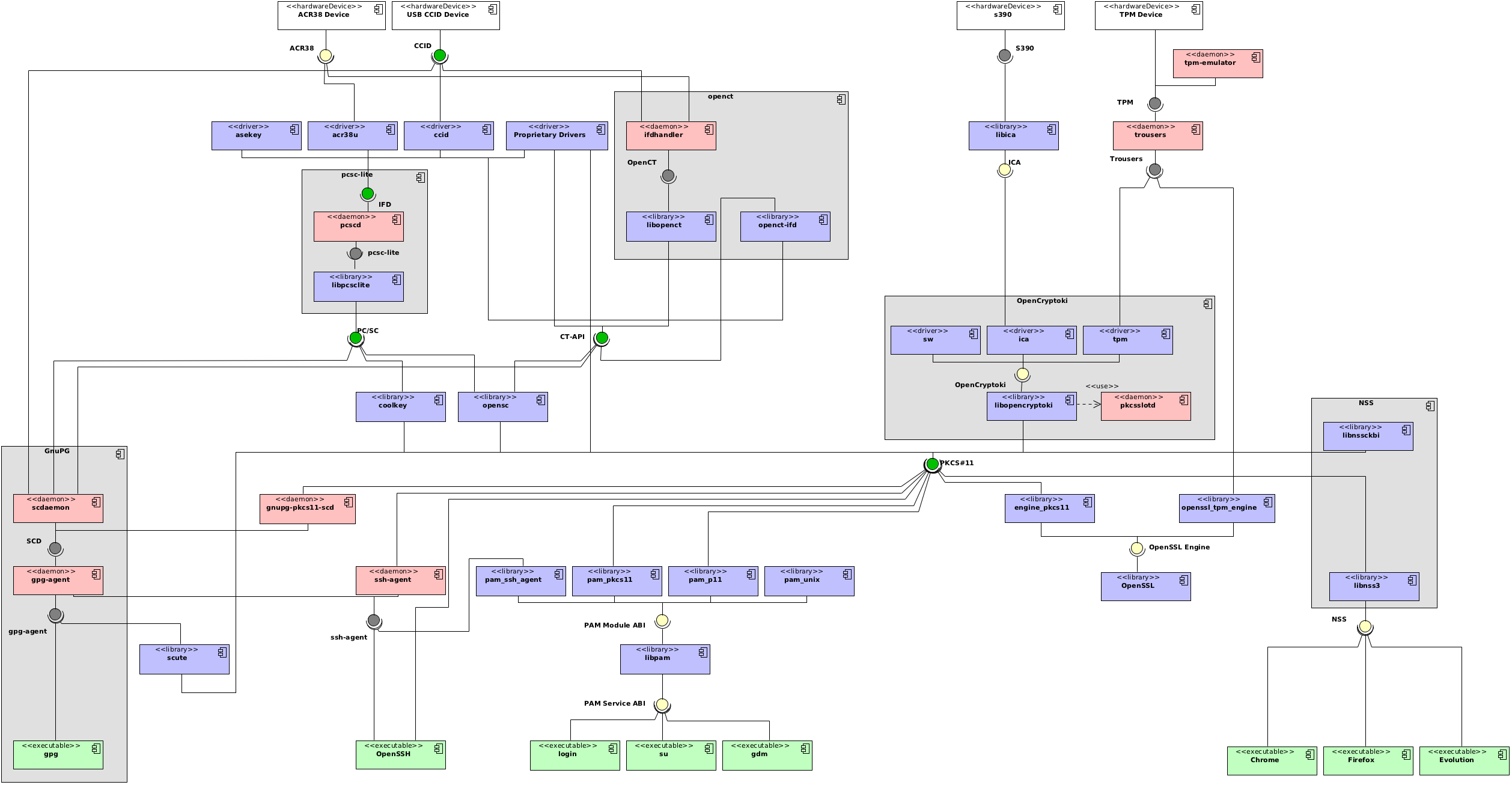Let’s clear first a big mess. In this post I’m going to talk about dev-libs/nss or, as the title suggests, Network Security Services which is the framework developed by Netscape first, and Mozilla Project now, for implementing a number of security layers, including (especially) SSL. This should not be confused with many others similar acronym, especially with the Name Service Switch which is the interface that allows your applications to resolve hosts and users against database they aren’t designed to use in the first place.

In my previous posts about smartcard-related software components – first and second – I started posting an UML components diagram that was not very detailed but generally readable. With time, and with the need to clarify my own understanding of the whole situation, the diagram is getting more complex, more detailed, but arguably less readable.
In the current iteration of the diagram, a number of software projects are exploded in multiple components, like I originally did with the lone OpenCryptoki project (which I should have been writing about but I hadn’t had enough time to finish cleaning off yet). In particular, I split the NSS component in two sub-components: libnss3 (which provides the actual API for the applications to use), and libnssckbi that provides access to the underlying NSS database. This is important because it shows how the NSS framework actually communicates with itself through the use of the standard PKCS#11 interface.
Anyway, back to NSS proper. To handle multiple PKCS#11 providers – which is what you want to do if you intend to use a hardware token, or a virtual one for testing – you need to register them with NSS itself. If you’re a Firefox user, you can do that from its settings windows, but if you’re a Chromium user, you’re mostly out of luck for what concerns GUI: the official way to deal with certificates et simila with Chromium is to use the NSS command-line utilities available with the utils USE flag for dev-libs/nss.
First of all, by default Mozilla, Evolution and Chromium, and the command-line utilities use three different paths to find their database: one depending on the Mozilla profile, ~/.pki/nssdb and .netscape respectively. Even more importantly, by default the first and last will use an “old” version of the db, based on the Berkeley DB interface, while the other two will use a more modern, SQLite-based database. This is troublesome.
Thankfully, the Mozilla Wiki has an article on setting up a shared database for NSS which you might want to do to make sure that you use the same set of certificates between Firefox, Chromium, Evolution and the command-line utilities. What it comes to be is just a bunch of symlinks. Read the article yourself for the instructions; on the other hand I have to note you to do this as well:
~ % ln -s .pki/nssdb .netscapeThis way the nss utilities will use the correct database as well. Remember that you have to logout and log back in to tell the utilities and Firefox to use the SQL database.
Unfortunately I haven’t been able to get a token to work in this environment; from one side I’m afraid I might have busted the one Eva sent me (sigh! but at least it served the purpose of getting most of this running); from the other, Scute does not allow to upload an arbitrary certificate, but only to generate a CSR, which I obviously can’t get signed by StartSSL (which is my current certificate provider). Since I’m getting paranoid about security (even more so since I’ll probably be leaving my servers in an office when I’m not around), I’ll probably be buying an Aladdin token from StartSSL though (which also means I’ll be testing out their middleware). At that point I’ll give you more details about the whole thing.

Which software do you use to make diagram/Workflow?Thanks in advance!
Please keep it going, this stuff is very interesting
Thanks Francesco :)The software used in (all) the UML diagrams I published is “Visual Paradigm for UML”:http://www.visual-paradigm…. — it is not free software, but it’s the only one I could find that worked reliably, on Linux and OSX as well.
Thanks for the answer!!! And as Francesco said keep it going it’s very interesting.
Hello Diego,Just a small fix. The link on the term ” Name Service Switch” is actually pointing to “http://en.wikipedia.org/wik…“.Great post, congratulations!